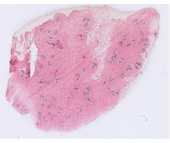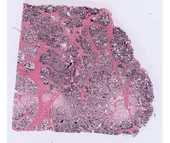Breast
The mammary gland is a cyclic organ, varying in size and structure in response to hormones from the adrenal, ovary and pituitary. The two slides in your collection represent two of the extremes normally encountered. You should realize that this gland is normally subject to a great deal of variation.
#70 Breast, Post-menopausal, Human (H&E)
 The breast contains a duct system, lobes, and lobules. This network of ducts begins at the nipple with the excretory lactiferous duct, which branches as it extends into the collagen and adipose tissue of the breast until it eventually branches into terminal duct lobular units. The terminal duct lobular unit consists of interlobular stroma, interlobular duct, terminal duct and acini, and surrounding fat. Identify these units on low power. With higher power, note that the ducts and acini are lined by simple cuboidal or columnar epithelium and surrounding myoepithelial cells.
The breast contains a duct system, lobes, and lobules. This network of ducts begins at the nipple with the excretory lactiferous duct, which branches as it extends into the collagen and adipose tissue of the breast until it eventually branches into terminal duct lobular units. The terminal duct lobular unit consists of interlobular stroma, interlobular duct, terminal duct and acini, and surrounding fat. Identify these units on low power. With higher power, note that the ducts and acini are lined by simple cuboidal or columnar epithelium and surrounding myoepithelial cells.
The mammary gland in the prepubertal female and male has a similar appearance. There is abundant connective tissue with embedded lactiferous ducts, ending in minimal lobule formation.
#69 Breast, Lactating, Human (Osmium fixation)
Unsaturated lipid in the apical cytoplasm of the alveolar cells and in the milk in the lumina is stained black by reduced osmium tetroxide. Because osmium penetrates very poorly the tissue is well stained only at the periphery of the section. The gland is separated into lobules by dense connective tissue that is continuous with the dermis. The connective tissue surrounding the alveolus is much more delicate (although compressed here) and is continuous with the papillary layer of the dermis. The secretory alveoli are very well supplied with capillaries.
What are the major hormones that are responsible for the cyclic changes in the mammary gland?

